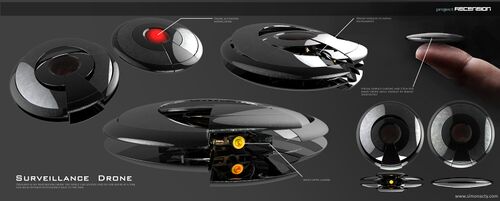| Line 14: | Line 14: | ||
== Command / Control == | == Command / Control == | ||
The | The drone utilizes a simple neural network AI which is able to make basic decisions based on command parameters in set programs. The on board AI is able to run a number of set surveillance programs and able to do minor improvisations based on those programs. Since the AI is limited, the drone works best when being controlled externally and the on board AI is used to either make recommendations or execute simple patterns under the direction of the external controlling terminal. | ||
When outside of the 150 km primary control radius the AI makes decisions based on its selected program and parameters last issued. For simple tasks such as stationary surveillance or tasked with staying within range of a defined target the on board AI is able to make reasonable decisions to not reveal its location and complete the programmed objectives. The AI can be programmed to return to its point of origin to shut down and wait to be retrieved, transmitting a final location before powering down. | |||
== Signal Loss == | == Signal Loss == | ||
Revision as of 00:02, 21 May 2021
There are multiple variants of this technology, please refer to Drone Disambiguation for a list of the variants. |

The short range tactical surveilling drone is only 2.5 cm in diameter. It is powered by a Spacial Variance Reactor at its core powering a simple anti-gravity array allowing it to fly in most environments. It has a range of about 150 km and a maximum speed of around 5 kps. It is designed to be exceptionally small and maneuverable, the built in simple AI seeks out the best vantage point where it can gather the most data. Usually the drone will automatically seek to stay as close to its maximum range from its host launcher as possible in the direction of travel to provide the most data. The battery life span is about 6 hours, though it can find compatible power sources and absorb power through inductive charging. If left completely on automatic and the drone was not previously directed not to, it will seek out a way to replenish its power supply.
The device is built out of a sensor-resistant material, the size and material make the drone nearly undetectable.
Sensors
It has a multi-optic camera that can see in wavelengths of light from the infra-red all the way up to microwaves. Detectors on board can also detect near-by radio and subspace energy sources. Sensor data is relayed back to the source using a subspace datalink, the most data can be transmitted within the 150 km range along with the primary control signal. However, the drone is capable of storing its sensor data for later transmission should communication be cut off temporarily.
Communications
Due to the size of the drone, it has a limited communications capability. The primary communications array is omnidirectional and has a range of around 150 km. This array can handle real time sensor data and commands / control. The drone also has a secondary array which is a low-bandwidth subspace array which has a greater range (around 424 km) with is not sufficient for real time command / control or the relaying of sensor data. The drone will respond to commands on either array but relies on the secondary array for position tracking and programming updates.
Command / Control
The drone utilizes a simple neural network AI which is able to make basic decisions based on command parameters in set programs. The on board AI is able to run a number of set surveillance programs and able to do minor improvisations based on those programs. Since the AI is limited, the drone works best when being controlled externally and the on board AI is used to either make recommendations or execute simple patterns under the direction of the external controlling terminal.
When outside of the 150 km primary control radius the AI makes decisions based on its selected program and parameters last issued. For simple tasks such as stationary surveillance or tasked with staying within range of a defined target the on board AI is able to make reasonable decisions to not reveal its location and complete the programmed objectives. The AI can be programmed to return to its point of origin to shut down and wait to be retrieved, transmitting a final location before powering down.
Signal Loss
In the event the drone is unable to lock onto a friendly signaling station, it will attempt to return to its host / launch origin. Should that be impossible, it will attempt to land and await further instructions to conserve power.